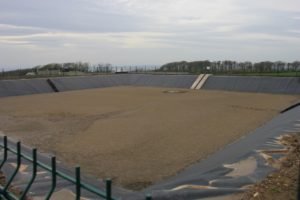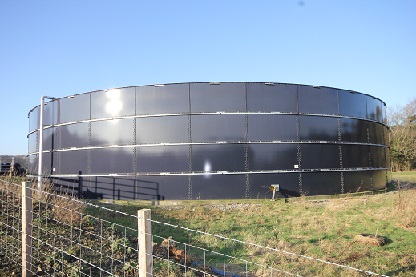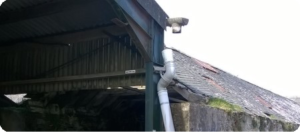Slurry is a valuable source of nutrients and when used appropriately, can help to reduce the reliance on bagged fertilisers.
It is also a highly polluting material that must be managed and contained securely. When looking at slurry storage on farm, the options are above ground tanks, below ground concrete tanks and earth bank lagoons with sheet liners. You also might want to look at ways to keep clean and dirty water separate around the steading and consider Rural SuDS systems as a way of treating lightly contaminated water, instead of putting additional liquid into your slurry storage system.
Constructing additional storage
When calculating how much slurry storage is required, a Farm Waste Management Plan (FWMP) should be produced which takes into account livestock numbers, ages, housing period and current storage capacity. Effluent from silage clamps, yard scrapings from collecting or loafing areas and parlour washings should also be accounted for in your FWMP. To cut down pressure on storage, clean and lightly contaminated water around the steading could be dealt with separately by a Rural SuDS; keeping excess water out of your storage tank means more space for slurry. There can be financial savings to be made too from the reduced time and energy required to pump or spread the additional liquid.
There are a number of rules and regulations governing the construction of new slurry storage facilities, and Scotland's Farm Advisory Service has produced a useful 'Frequently Asked Questions' sheet for regular queries surrounding the construction of slurry lagoons.
Useful links
- Farm Waste Management Plan

- Steading Drainage Assessment
- KTR Factsheet 1 - Slurry and manure storage
- KTR Factsheet 2 - Maintaining slurry storage systems
- KTR Factsheet 9 - RAMS; Risk Assessment for Manure and Slurry
- Slurry Lagoon Storage & Construction Frequently Asked Questions
- Rural Sustainable Drainage Systems: A practical design and build guide for Scotland's farmers and landowners
- Livestock manure and silage storage infrastructure for agriculture (C759)
- DEFRA: Code of Good Agricultural Practice for reducing ammonia emissions.
- Scotland's Farm Advisory Service - Podcast: 'Slurry Lagoons - More than just a hole in the ground'
Slurry Storage Maintenance
Aside from a loss of nutrients, there are huge environmental impacts as a result of a slurry or effluent spill and a risk of subsequent financial penalties afterwards, so regular maintenance and checking of slurry storage facilities is vital to prevent problems. Farmers are required to maintain facilities in good working order to prevent a risk of pollution to the environment.
Structures built prior to 1991 can still be used if kept well maintained and in a good state of repair with no risk of pollution. All structures built after 1991 that contain either silage or slurry must comply with strict building standards to reduce pollution risk and to ensure that they can withstand use for 20 years.
Keeping areas around slurry stores, such as concrete bases, should be kept free of soil, debris and vegetation to allow for any leakage to be identified and repaired promptly. Additionally, trees and shrubs must not be allowed to establish within rooting distance of lagoons and above ground stores.
Pest control of burrowing mammals and rodents around earth banked lagoons will reduce the risk of damage to liners and subsequent slurry leaks.
Most slurry storage manufacturers will provide details of recommended maintenance which will ensure that the product is fit for use during the expected lifespan. These include tasks such as:
- Checking and maintaining all valves, greasing these annually when the store is empty
- Visually inspecting the tank; metal towers can show corrosion at the point where sheets meet and join; degradation of the mastic between sheets can cause failure, resulting in a spill. Rust spots or electrolytic corrosion can be seen on metal stores whereas cracks in concrete structures can indicate a weakness and should be investigated further to prevent a catastrophic fail
- Check for tightness and corrosion in the hoops, cables and straps for post-tensioned concrete above ground stores
- All slurry lagoon liners should be inspected annually when the store is empty. Any liner defect will need repaired or replaced
- Slurry lagoon leak detection systems should be regularly inspected and all chambers and pipes kept clear of debris
- Earth banks should be checked for any subsidence
- Concrete floors and aprons should be inspected for cracks or holes which will need repaired immediately to prevent further erosion or structural failure
There is more information on slurry store maintenance in our KTR Factsheet 2 - Maintaining slurry storage systems.
Contingency Plans
All farm businesses with slurry and effluent tank facilities should have a contingency plan in place to deal with a structural failure. This plan should be kept in an accessible area and shared with farm staff and family members. A copy of the farm Risk Assessment for Manures and Slurries (RAMS) map should be available with this contingency plan to help identify  areas of potential risk around the farm.
areas of potential risk around the farm.
If you find a structural failure you must work to prevent slurry or effluent reaching any ditch, watercourse or freshwater pond on your farm. You need to report the incident to SEPA and discuss how to prevent any pollution and what repairs or replacements to the storage facility are required. The regulations surrounding slurry and silage effluent allow for a certain number of repairs to be carried out to existing structures, however it is important these are agreed with SEPA in advance.
What to do in an emergency
- Report the incident to SEPA either by calling the local office or by using the 24-hour pollution hotline 0800 807060
- Where possible, contain the slurry or effluent by directing it to another tank on the farm.
- Dig sumps and blind ditches to intercept and hold any slurry or effluent that could run into ditches and burns. Be prepared to transfer this slurry into other storage facilities or apply it to land if conditions are suitable.
- If applicable, use a temporary sump, lined with plastic, to manage effluent from structures that cannot be repaired or decommissioned straight away. You must manage the levels in the temporary sump to ensure that no overflow occurs.
Reduce the risk - Keep clean and dirty water separate
Climate change projections suggest we will experience warmer, wetter winters. This could increase the proportion of dirty water and slurry we have to deal with around the steading.
Take another look at ways to keep clean and dirty water separate around the steading and consider Rural SuDS systems as a way of treating lightly contaminated water, instead of putting additional liquid into your slurry storage system.
Following heavy rain, take a look at the route runoff takes around the steading or areas where water accumulates. Could you reduce the volume or divert clean rainwater runoff?
- Roof water – make sure gutters are clear and fitted to serviceable downpipes to get the water straight into the drains and off the steading. Some farmers are already fitting larger sized guttering and down pipes on new buildings to deal with increased rainfall.
- Is ‘clean’ rainfall contributing to your collection systems? Calculations on a SW Dairy farm suggested that this was costing around £0.93/m3 to handle, store, transport and spread.
- A constructed farm wetland may be suitable to take lightly contaminated water from around the steading, rather than diverting to slurry collection systems. Other Rural SuDS (Rural Sustainable Drainage Systems) may also be worth considering and could attract AECS grant funding support.
- Risk Assessment for Manures and Slurry (RAMS) - Where possible, make sure slurry storage systems are empty going into the housed period. Use a RAMS map to identify low-risk areas for spreading, should you be forced to put slurry out over the winter months with no crop demand.
Read more on our "Ideas for keeping clean and dirty water separate" webpage, or download our 'Managing Dirty Water Around The Farm Steading' handout.
